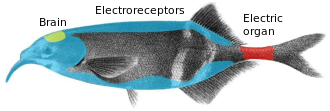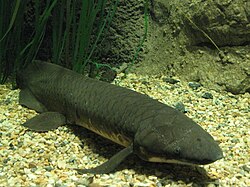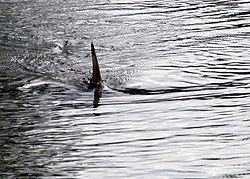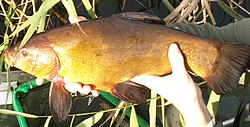Electroreception and electrogenesis are the closely related biological abilities to perceive electrical stimuli and to generate electric fields. Both...
41 KB (3,592 words) - 01:40, 25 May 2025
J. S., and W. G. R. Crampton. 2005. Electroreception and electrogenesis. Pp. 431–472 in The Physiology of Fishes, 3rd Edition. D. H. Evans and J. B. Claiborne...
31 KB (3,235 words) - 06:20, 3 June 2025
Ampullae of Lorenzini (section Electroreception)
physically associated with and evolved from the mechanosensory lateral line organs of early vertebrates. Passive electroreception using ampullae is an ancestral...
20 KB (2,082 words) - 04:16, 25 May 2025
Fish (section Electrogenesis)
York: Farrar, Straus and Giroux. ISBN 9780374207946. Albert, J. S.; Crampton, W. G. (2006). "Electroreception and Electrogenesis". In Lutz, P. L. (ed...
103 KB (10,247 words) - 20:09, 12 June 2025
accompanied by their possible meanings. Scientific names for individual species and higher taxa are included in parentheses. Contents: Top 0–9 A B C D E F G...
26 KB (1,988 words) - 19:52, 17 May 2025
Albert, J.S., and W.G.R. Crampton. 2005. Electroreception and electrogenesis. pp. 431–472 in The Physiology of Fishes, 3rd Edition. D.H. Evans and J.B. Claiborne...
25 KB (2,938 words) - 11:29, 28 May 2025
Fish physiology (section Electroreception)
Albert, J.S., and W.G.R. Crampton. 2005. Electroreception and electrogenesis. pp. 431–472 in The Physiology of Fishes, 3rd Edition. D.H. Evans and J.B. Claiborne...
80 KB (9,831 words) - 20:28, 7 June 2025
Electric fish (section Evolution and phylogeny)
S2CID 13359966. Albert, J. S.; Crampton, William G. R. (2006). "Electroreception and electrogenesis". In Evans, David H.; Claiborne, James B. (eds.). The Physiology...
32 KB (2,961 words) - 06:30, 23 May 2025
Species. Modern study began with Hans Lissmann's 1951 study of electroreception and electrogenesis in Gymnarchus niloticus. Detailed descriptions of the powerful...
25 KB (2,344 words) - 13:53, 28 May 2025
Shark (redirect from Shark senses and behaviors)
slits on each side, and pectoral fins that are not fused to the head. Modern sharks are classified within the division Selachii and are the sister group...
145 KB (14,427 words) - 15:31, 5 June 2025
Lungfish (section Anatomy and morphology)
characteristics within the Osteichthyes, including the ability to breathe air, and ancestral structures within Sarcopterygii, including the presence of lobed...
44 KB (3,952 words) - 14:29, 24 May 2025
Photophore (section Future research and applications)
species of fish and cephalopods. The organ can be simple, or as complex as the human eye, equipped with lenses, shutters, color filters, and reflectors; unlike...
22 KB (2,489 words) - 12:02, 11 June 2025
most often by wave-like lateral flexions of the fish's body and tail in the water, and in various specialised fish by motions of the fins. The major...
49 KB (5,929 words) - 00:34, 21 December 2024
Egg case (Chondrichthyes) (redirect from Egg case (skates, rays and sharks))
cases include some sharks, skates and chimaeras. Egg cases typically contain one embryo, except for big skate and mottled skate egg cases, which contain...
15 KB (1,840 words) - 12:59, 26 May 2025
A dorsal fin is a fin on the back of most marine and freshwater vertebrates. Dorsal fins have evolved independently several times through convergent evolution...
8 KB (880 words) - 15:23, 12 January 2025
Freshwater fish (section Sources and references)
all of their lives in bodies of fresh water such as rivers, lakes, ponds and inland wetlands, where the salinity is less than 1.05%. These environments...
29 KB (3,280 words) - 17:24, 23 May 2025
and surrounding environment lead to a generation of alternating sideways forces that act to move the animal forward. These forces generate thrust and...
25 KB (3,291 words) - 12:33, 3 June 2025
fish of the family Tripterygiidae. Found in tropical and temperate waters of the Atlantic, Pacific and Indian Oceans, the family contains about 150 species...
5 KB (371 words) - 21:40, 8 November 2024
(using paired fins and tail), and jumping. Many of these methods of locomotion incorporate multiple combinations of pectoral-, pelvic-, and tail-fin movement...
10 KB (1,150 words) - 13:05, 7 June 2025
Juvenile fish Fish go through various life stages between fertilization and adulthood. The life of fish start as spawned eggs which hatch into immotile...
20 KB (2,412 words) - 11:52, 6 June 2025
Bichir (section Diet and traits)
portal Bichirs /ˈbɪʃɪərz/ and the reedfish comprise Polypteridae /pɒlɪpˈtɛrɪdiː/, a family of archaic ray-finned fishes and the only family in the order...
15 KB (1,307 words) - 23:13, 1 June 2025
Flying fish (section Distribution and description)
fish" and the fish is one of the national symbols of the country. The Exocet missile is named after them, as variants are launched from underwater, and take...
22 KB (2,260 words) - 00:42, 24 May 2025
Shoaling and schooling In biology, any group of fish that stay together for social reasons are shoaling, and if the group is swimming in the same direction...
106 KB (12,235 words) - 18:29, 28 May 2025
the single living genus, Amia with two species, the bowfins (Amia calva and Amia ocellicauda), as well as the Ginglymodi, the sole living representatives...
16 KB (1,393 words) - 15:14, 15 February 2025
Swim bladder (section Structure and function)
internal gas-filled organ in bony fish that functions to modulate buoyancy, and thus allowing the fish to stay at desired water depth without having to maintain...
28 KB (3,448 words) - 15:15, 24 May 2025
sea anemones, starfish, snails, bristleworms and sea cucumbers—and benthivore or benthivorous, for fish and invertebrates that feed on material from the...
9 KB (926 words) - 01:52, 24 May 2025
Fish gill (section Lampreys and hagfish)
that allow fish to breathe underwater. Most fish exchange gases like oxygen and carbon dioxide using gills on both sides of the pharynx (throat). Gills possess...
21 KB (2,525 words) - 07:23, 6 March 2025
(Schindleria brevipinguis) where females reach it at 7 mm (0.28 in) and males at 6.5 mm (0.26 in), and Photocorynus spiniceps where males can reach it at 6.2 mm...
6 KB (442 words) - 03:44, 17 May 2025
Batomorphi (redirect from Rays and skates)
Holmes; Hopkins, Carl D.; Popper, Arthur N.; Fay, Richard R. (2005). Electroreception. Springer. pp. 5–7. ISBN 978-0-387-23192-1. Faria, Vicente V.; McDavitt...
29 KB (2,435 words) - 14:16, 23 May 2025
order Acipenseriformes. It is found primarily in the Caspian and Black Sea basins, and formerly in the Adriatic Sea. Based on maximum size, it is the...
25 KB (2,811 words) - 20:23, 11 June 2025



























